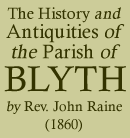< Previous | Contents | Next >
TABLE OF CONTENTS.
INTRODUCTION.
General physical appearance of North Nottinghamshire; cars of Styrrup, Everton, and Gringley; Bassetlaw; geological character of the country; sections exhibited by the coal-mine at Shireoaks; chemical analysis of the soil; British, Roman, Saxon, Danish, and Norman eras; Sherwood Forest; Domesday Survey, explanation of some terms used in topography of the shire
CHAPTER I.
De Builli, the first Norman Lord of the Honour of Tickhill, and founder of the Monastery of Blyth; his estates in the counties of Nottingham and York; his family; Tickhill Castle, his capital residence, account of, and of Chapel Royal of Queen Eleanor within its walls; the Honour of Tickhill, its descent, till finally incorporated in the Duchy of Lancaster; sieges of the castle by Pudsey Bishop of Durham (with brief account of this prelate), and Thomas Earl of Lancaster; surrender of to forces of Parliament in the Rebellion; Church of Tickhill and Priory of St. Augustine
CHAPTER II.
Antiquity of the name of Blyth; Ancient castle and church, the existence of, considered; Foundation Charter of Benedictine Convent; analysis of its privileges and possessions; confirmation of its rights by Henry I., Stephen, Henry II., and Earl John; surveys of its estates in Taxation of Pope Nicholas, Nona? Roll, Inquisition of 1379, Valor Ecclesiasticus, and Paper Surveys of Henry VIII.
CHAPTER III.
Constitution of the Convent of Blyth; alien priories, their nature, treatment of during wars with France; establishment and expenditure of Blyth Priory; its domestic arrangements and daily life List of Priors; conventual and parish church under one roof, its original plan, subsequent improvements and changes; bells and chimes; guilds; lights; lands; monuments; ordinations held in; destructions, severances, and mutilations of; unsuccessful attempt made to restore; only perfect manner of restoration of pointed out; the Vicarage; earliest existing endowment of; supplement to; value of the benefice in time of Henry VIII.; additional minister endowed to assist vicar; wisdom of such endowments, and mischief arising from their spoliation; survey of vicarage 5th Elizabeth; ancient manses; abbey lands, modus upon; catalogue of vicars, with biographical notice of Rev. John Rudd; requirements of the parish
CHAPTER IV.
Measures of spoliation prior to the destruction of the monasteries by Henry VIII.; Roche and Worksop, neighbouring convents of; their condition at the time of their suppression; Blyth Convent, suppression of; grant of site and demesnes; alienation of; descent of; Saunderson family, account and pedigree of, with brief history of life and writings of Bishop Saunderson; his church at Boothby Pagnell; family of Mellish; their pedigree; Edward Mellish rebuilds Blyth Hall; manor of Blyth; family of Walker; rectory of the parish; parish school; charities; Blyth Norway; concluding remarks
CHAPTER V.
Barnby Moor; ancient condition of the township, as gathered from charters; manor of, united with that of Blyth; other possessions of convent of Blyth here, probable fate of; modern proprietors; tithes, great and small, commuted for land; opinion of Bishop Horsley on this subject; Bilby, incorporated with Barnby Moor; families of Fitz-Ranulph, Orreby, Chaworth, Hewet, Osborne (postea Dukes of Leeds), Clifton, Levinz, Vane, Foljambe, proprietors of; pedigree of Vane of Bilby; the tithes of Bilby . .
CHAPTER VI.
Torworth; ancient family of Moles, grantees of the Manor of Serlby with Torworth from Roger Mowbray; brief historical account of Mowbray and his descendants till allied with Howards; descent of the manor through the families of Moles, Serlby, and Saunderson, to that of Monckton; School of Harworth founded and endowed by Brailsford and Mary Saunderson; Torworth estate enlarged by Moncktons; families of Cromwell, Banks, and Sutton, with memoir of John Cromwell, nonconformist minister of Clayworth; pedigree of noble family of Monckton Arundell, Viscounts Galway; Sir Philip Monckton and other members of this family
CHAPTER VII.
Ranskill; a manor of Archbishops of York from Conquest; ancient diocese of York; Edwin, Paulinus; Aidan and See of Lindisfarne; his successors; division of Northumbria into four dioceses, of York, Hexham, Lindisfarne, and Whitherne; plan of Gregory the Great and Beda for increase of episcopate; modern legislation on this subject; possessions and privileges of ancient sees; early condition of Ranskill; proprietors in 17th and 18th centuries; Bishopfield; Tithes of; Archiepiscopal courts of North Soke; Palace of Scrooby; Wolsey
CHAPTER VIII.
Hodsock; its divisions; probable meaning of name; first Lord of Hodsock after Conquest, Torald de Lizours; Cressys, second lords; their estates; intestine rebellions in reigns of Henry II., Richard I., John, and Henry III.; great men of North Notts, in arms against John; of whom William Cressy one; founds hospital of lepers and chapel at Hodsock; he and his descendants benefactors to convent of Blyth; pedigree of Cressy; wills of Sir Hugh and Sir John Cressy; estates of Cressys go to Cliftons and Markhams, through co-heiresses; Markhams; Cressy Hall; Cliftons, third lords of Hodsock; early descent; pedigree; brief accounts of some members of the family, with wills of 15th and 17th centuries; Mellishes, fourth lords of Hodsock; ancient residence or hall of Hodsock; present gateway; ancient chapel; nature of these chapels; very common in ancient times; hospital of lepers and district called Spital; endowments of hospital; their fate; districts of Holm, Hermeston, Goldthorp, Costrup, Woodhouse, Hodsock Park, and Fleecethorp; tithes; monster modus of Great Hodsock; nature and injustice of moduses
CHAPTER IX.
Olcotes and Styrrup, manor of; its descent; families of Lizours and de Stirap; Philip of Olcotes, his public life in reigns of John and Henry III.; Darcys; Cressys; families of Lovetot, Furnival, and Talbot; the latter, proprietors in Styrrup; Sheffield Hospital; its property in this township; tithes; ancient Tournament Field between Blyth and Styrrup; the licences and rules of Richard I. for tournaments; a tournament at Blyth; mention of the field in subsequent reigns
CHAPTER X.
Bawtry and Austerfield; early history and descent of the manors, through the families of Vipont, Despenser, Beauchamp, and Neville, to those of Lister and Milnes; the chapelries; Hospital of St. Mary Magdalene; Robert Morton; Bishop Lake; schools; new benefice of Bawtry cum Austerfield
